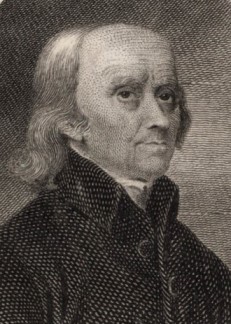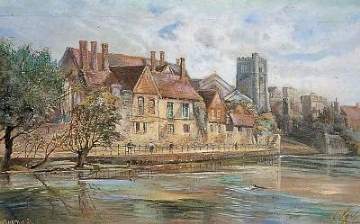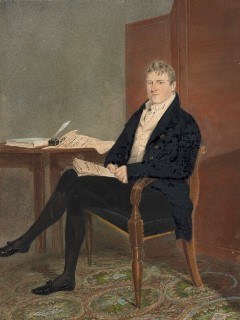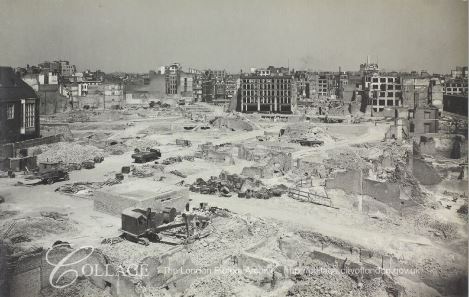john farmer wiche
According to census records, John was born in Stepney in 1796 but no birth or baptismal record has been found to confirm this nor do any of the available records list his parents’ names. The record of his marriage to Hannah Sarah Mallandain on 26 November 1814 indicates that he was from the parish of St Michael Bassishaw in Clerkenwell which lay to the north of St Paul’s Cathedral and on what is now the site of the Barbican Estate.
John and Hannah remained in Clerkenwell and their first daughter, Eleanor Sharah, was born on Beech Street and her birth was registered at Dr. Williams’ Library which maintained a registry of births in non-conformist families. Their second daughter, Elizabeth, died aged 3 years and was buried at the General Baptist Chapel in Worship Street. The family moved to the hamlet of Ratcliffe in Stepney but returned to Jewin Street in Clerkenwell twenty five years later. John worked as a Miniature Painter and his subjects included the Reverend Caleb Evans, Drury Lane comedian Edward Knight, and Mrs. P. Mallandain. In 1841, his occupation changed to Clerk and later to a Printer and Publisher’s Assistant.
Although John’s parents aren’t known, there are records of a Thomas Wiche working as a Bookseller in Beech Street between 1790 and 1819. He was born in Maidstone, Kent to John Wiche, a baptist minister, and Elizabeth Pine. There are numerous adverts in contemporary newspapers and periodicals confirming that Thomas sold non-conformist leaflets and books including many written by his brother-in-law, John Evans, the minister of the General Baptist Chapel in Worship Street, Shoreditch.
Since Wiche is not a name commonly found in London, it seems too much of a coincidence that two unrelated families lived on Beech Street at the same time. In additional to the location, John’s work in printing and publishing, the non-conformist births and burials in his own family, and the names of their daughters (Thomasine and Eleanor) all provide potential links to Thomas and his wife as John’s parents. This has yet to be confirmed but the following family history is based on the presumption that John is their son.
john wiche + elizabeth pine
John was born into a Baptist family in Taunton, Somerset on 24 April 1718. His parents were members of the Mary Street Baptist Church into which John Was baptised on 25 June 1734. With financial support from the General Baptist Fund, John was able to pursue his studies at baptist acadamies in Taunton, Trowbridge in Wiltshire, Kendal in Cumbria, and Findern in Derbyshire. In 1743, he obtained a position as an assistant at a chapel in Salisbury, Wiltshire and later took over as the minister to the small congregation. Three years later, John considered leaving ministry but was persuaded to take up the position of minister to a general baptist congregation in Maidstone, Kent. As a small congregation, they had difficulty maintaing a minister but in 1745, six members including Thomas Pine (senior and junior) and John Pine committed funds to support a new minister. Despite John’s earlier concerns about continuing as a Baptist minister, he served the members of the Maidstone chapel for 46 years.

John married Elizabeth Pine in Maidstone on 4 April 1755. Elizabeth, born about 1736, was one of six children born to Thomas Pine and Mary Jordan. John and Elizabeth had six children over the next eleven years and although, no birth or baptism records have been located for their children, other contemporary records provide the year of birth of five of their six children. Their eldest son, Thomas, was born in 1757 and they had a second son, John, but the only records relating to him are contained in family wills. They had four daughters: Sarah born in 1759, Elizabeth on 24 January 1761, Mary in 1763, and Jane in 1764.
On 16 April 1766, Elizabeth Pine died, aged just 30 years, and was buried in the Pine family plot at the Tovil Anabaptist Burial Ground in Maidstone. Her ancestor, Simon Pine, had gifted the land as a dissenter’s burial ground in the mid 17th century and was buried there following his death in 1681. With six children under the age of ten to care for, it appears that John was able to enlist the help of family members as at least one son, Thomas, lived with his uncle Thomas Jordan Pine and likely learned his trade from his uncle who was a Stationer. The family suffered another loss when Elizabeth died in Maidstone when she was just 17.
Two years later, Sarah married Sampson Kingsford in Maidstone on 4 January 1780. Sampson was working as a Miller when they married but later moved into banking and like his father-in-law, he became a minister to a baptist congregation in Canterbury. Sarah gave birth to a daughter, Sarah Maria, on 16 April 1782 in Canterbury but sadly, she died two weeks later and was buried in the Kingsford family vault at the Blackfriars General Baptist chapel in Canterbury. The chapel was originally part of the Dominican or Blackfriars monastery, founded in 1237, that lay on either side of the River Stour near what is now Blackfriars Street and was used as a baptist chapel from 1640 to 1912.
John died in Maidstone on 7 April 1794, aged 76 years, and was buried in the family plot at Tovil with daughter Elizabeth. He appointed his broter-in-laws Thomas Pine, a Stationer of Maidstone, and William Limbery Grosvenor, a Stationer of Corn Hill in London, and his son-in-law Sampson Kingsford as joint executors of his estate. William Grosvenor was the son of Thomas Pine’s daughter Mary and her husband also named William Limbery Grosvenor and to complete the family connections, Mary Wiche was present at his birth on 1 January 1778.
In his will, John asked his executors to sell all of his property including ‘that old mansion house divided into two tenements one in my own occupation and one in the (?) of Miss Sampson spinster with the garden, ground, outhouses, yard situate lying and being in the street commonly called Bullock Lane in Maidstone’. On 10 November, his household possessions were auctioned by Green & Son from his home, described as ‘the Mansion House, Earl Street, Maidstone’ and the proceeds funded legacies of £105 to his grand-daughter Sarah Maria Kingsford, £100 each to his sons Thomas and John, and the remainder of his estate to his daughters Mary and Jane. It appears that John may have been the black sheep of the family as his legacy was not to paid directly as with the others but instead it was to be managed by the executors with interest earned paid weekly or quarterly as they saw fit.
Mary married John Evans, a baptist minister from Wales, on 25 August 1795 in Maidstone. John was born in Usk, Monmouthshire on 2 October 1767 and came from a long line of baptist preachers dating back to the Commonwealth. He studied at Bristol before attending King’s College in Aberdeen and then the University of Edinburgh where he received his M.A. in 1791. He accepted an invitation to assist at the General Baptist Chapel on Worship Street in Shoreditch and several months later, he was invited to be their pastor and was ordained on 31 May 1792.

by Alfred F.W. Burton
John and Mary had four sons: John born on 6 November 1796, Hugh whose date of birth is unknown, Caleb born on 29 April 1801, and George Wiche born on 29 July 1803. Both John and George became barristers while Caleb followed his father into ministry but died at the family home on Pullins Row in Islington on 6 December 1821 after a four day illness. Reverend John Evans suffered from an illness that caused paralysis in his legs but despite his debility, he continued to preach and serve his congregation until his death on 25 January 1827.
Following his death, Mary moved in with her son John and his family in Mabeldon Place, St Pancras and lived there until her death on 9 May 1840. She was buried at the Baptist burial ground on Worship Street with her husband and their son, Caleb. In her obituary, her eldest son noted that she was educated as a Unitarian and a Baptist and cared for the students attending her husband’s school with affection and ‘maternal assiduity’. Her last years were not easy and her son noted that ‘the gradual loss of sight and general decay of her powers both mental and bodily brought her at length into a state of helplessness, which caused her more than once to say, that she was only waiting for Death, and that he was a long while coming.’
Jane never married and may have remained at home to help and care for her father. She died on 31 July 1822 and was buired in the family plot at the Tovil Anabaptist burial ground in Maidstone with her father and younger sister, Elizabeth. She left legacies of £300 to John Pine of Tovil, a Paper Maker, Thomas Pine, a Stationer, and Benjamin Chilley Pine, an Ironmonger, all of Maidstone and their two sisters Ann and Mary Pine of Rochester. It appears her brother John was no longer in contact with his family as evidenced by Jane’s legacy:
I give and bequeath unto my brother John Wiche if he be living and should he demand it, the sum of ten pounds and if he should not demand it within two years after my death then my will is that the said sum of ten pounds be equally divided between my brother Thomas Wiche and my sister Mary Evans wife of the Revd John Evans of Pullins Row Islington. All the remainder of my property of what kind soever I give and bequeath to my before mentioned brother Thomas Wiche Bookseller of Beech Street London and my sister Mary Evans to share and share alike but should they depart this life before me my will is that their share may be equally divided amongst their children share and share alike.
Jane’s will, written in 1807, was proved on 4 January 1823. Her brother Thomas had predeceased her by a year and his share of her estate passed to his surviving children.
thomas wiche + eleanor
Thomas was born in Maidstone about 1757 and grew up with uncles and cousins who worked as paper makers and stationers. He had a particularly close relationship with his uncle Thomas Pine, a stationer, and worked with him learning the trade before leaving Maidstone for London. He obtained a position with Thomas Field who had premises in Paternoster Row alongside St Paul’s Cathedral in Cheapside. From 1761, Field served as the bookseller for a charitable organization called the Society for Promoting Religious Knowledge among the Poor, known as the Book Society, and when he retired, Thomas succeeded him. The society did not commission new material but rather arranged for the printing and publishing of both classic and popular contemporary material including material written by the Reverend John Evans, Thomas’ brother-in-law. By 1790, Thomas was running his own shop, known as the Book Society Office, in Beech Street, Clerkenwell.

Thomas married and had children, as confirmed in his obituary, but neither a marriage record nor any birth or baptism records have been found to confirm the family ties. Thomas was raised as a Baptist with strong Unitarian influences and this may account for the lack of records as the Unitarians did not believe in Original Sin and therefore the need to baptize. Despite this, there are a number of other records thats provide a link to Thomas and help develop an outline of his descendants.
When Thomas died, he was buried in plot E2 at the burial ground adjacent to the General Baptist Chapel on Worship Street in Shoreditch. Four years later, an entry in the Worship Street register records a burial for thirty-four year old Thomas Wiche, son of Thomas Wiche, in plot E2 on 29 May. This places his year of birth as c. 1791 and as his father’s namesake, Thomas was very likely the eldest son.
In a second burial at Worship Street, seven year old Richard Wiche, son of Thomas and Eleanor Wiche of St Giles Cripplegate, was buried in plot E2 on 25 June 1809. This is the only record found that contains the name of Thomas’ wife and leads to a link to two more possible children. In the first quarter of 1851, a death was registered in the Greenwich registration district for 79 year old Eleanor Wiche. That same year, Robert Wiche, aged 43, and his 35 year old sister Eleanor were living on New King Street in Deptford, Kent which lies within the Greenwick registration district. Robert was working as a Hat Maker and employed two men and contemporary Post Office directories place him at that address from 1845. Prior to that he appears in Broomfield Place in Deptford and a corresponding census record from 1841, lists Robert, a Hatter, Eleanor and 70 year old Eleanor at that same address. The 1841 census does not list the place of birth but both Robert and his sister were marked as not being born in the county of Kent while Eleanor the elder, and presumably their mother, was born in the county.
As noted above, John Farmer Wiche, born c. 1796, had ties to Beech Street and a link to Thomas but there is a second Wiche with similar connections to Beech Street. Mary Jane Wiche of Beech Street appears on a list of subscribers, along with a Miss Wiche of Maidstone, to the second edition of ‘Pastorals: To which is Added Pastorella, a Rural Tale’ by the late George Smith a landscape painter from Chichester in Sussex. The edition, publised in 1811 by Whittingham & Rowland, contained a preface by the editor the Reverand John Evans, and a list of booksellers including Thomas Wiche, Beech Street, Barbican.
In ‘The Christian Life’ newspaper dated Feb 12 1881, Mary replied to a request from a ‘TE’ of Maidstone for more information on the Rev John Wiche:
As a grand-daughter of the late Rev. J. Wiche of Maidstone, I am naturally interested in the inquiry respecting him which appeared in THE CHRISTIAN LIFE of 15th January; though I can give but litte information about my grandfather, who died long before my birth. It is quite certain the he lived many years in Maidstone; since my father, who was the eldest child, was born and grew to manhood in that town. It is also certain that Rev J Wiche was minister there; for I have a table spoon, very rarely used in our family, which was given to him by a humble member of his congregation name Charity Buss. How long he filled the pulpit, I never heard. He married a Miss Pine of Maidstone, who died very young, leaving him with five children, whom he educated with some other pupils. My grandfather died at Maidstone about the year 1790 and there must be, I think, a head stone in the burial ground at Tovil (I believe it is), or some other memorial of him connected with the chapel. I have heard my aunt, his eldest daughter, speak of Dr. Lardner as a dear and intimate friend of her father. This is I think, all the information I can give respecting my anscestor.
Mary appears in the census records from 1841 to 1891 and her year of birth over the years ranges from 1808 to 1818. She never married and worked as a School Mistress in Bath, Somerset; in 1848, she appears in the Hunt & Co. directory at the Unitarian Girls’ School in Saw Close, Bath but it is not known if she remained at that school for her entire career or worked elsewhere. In 1851, she was listed as a visitor in the home of 61 year old Eliza Godfrey, who was originally from Sidmouth in Devon, at her home at 17 Vineyards. Mary lodged at several locations during her 40 years in the Walcot area of Bath including 20 years on John Street with the Bell family. By 1891, she had retired and was living at 28 Cambrian Road in Richmond, Surrey where she died four years later.
The Worship Street burial register from 1821 listed Thomas’ home as Chiswell Street which changed to Beech Street when it intersected with White Cross Street. One year earlier, a George Wiche appears in the Land Tax records paying rent on Chiswell Street and the last year that Thomas appears in the tax records is 1819 for 12 Beech Street. George also appears in the Robson London Directory of 1820 as a Hatter operating at 18 Holywell Street in the Strand. He married Harriet Marnham at St George, Hanover Square on 6 May 1821 and they had five children — Harriet, George Thomas, John, Ellen Mary, and Harriet Elizabeth — all baptised in the established church. Following Harriet’s death, George married a second time to Frances Godfrey, born in Sidmouth, Devon in 1796.
George worked as a Hat Maker in retail shops in a number of locations including Woolwich, Kent in the early 1840s and Shepherd’s Market in Mayfair for 20 years from the late 1840s. By 1871, George and Frances were living on Hatfield Street in Southwark and his occupation was listed as a Chapel Keeper but their situation deteriorated to such an extent that they were forced to enter the workhouse on 5 November 1879 and both were listed as Unitarians on the admissions register. Sadly, they were separated shortly after when Frances was moved to the Newington Workhouse on Westmoreland Road and George was sent to Caterham in Surrey where he died early in the following year. Frances may not have been aware of her husband’s death before she died on 25 September 1880.
There was a second response to the query in the Christian Life newspaper regarding Rev John Wiche by a reader known only as ‘RS’ and it appears to confirm a connection between George and Thomas Wiche: ‘a grandson of Mr Wiche, many years the chapel keeper at Stamford-street, London, died last year, over eighty years of age.’
When Thomas died on 11 July 1821, a short notice appeared in the Public Ledger and Daily Advertiser newspaper stating only ‘after an extreme short and sudden illness, aged 64, Mr. Thomas Wiche’ but his brother-in-law, John Evans, spoke at length about Thomas at his funeral at the Worship Street Chapel and his eulogy was published in the Monthly Repository of Theology and General Literature Vol. XVI. Excerpts of the eulogy give a picture of the man and his unfortunate death:
My worthy brother-in-law, the late Mr. Thomas Wiche, died on Wednesday July 11, 1821, in the 64th of his age. Violent spasmodic affections of the chest were the means ordained by Providence for the termination of his mortal course. He was well the preceding day at dinner and the next morning a breathless corpse.(...)
His understanding was good, his dispostiion benevolent and in all his
dealings a man of singular honesty. Nothing could tempt him to do what
appeared to him wrong. No individual could lead him astray from the path of
rectitude. He had his peculiar views and habits but in every department of
conduct he exhibited an irreproachable integrity.
From his venerable parent he derived enlarged notions of Civil and Religious Liberty. These he cherised throughout life. Nothing gave him greater pleasure that to witness the diffusion of human happines, promoted by the operation of good government extending its ample wing over all the gradations of civilized society. He hated oppression, he abhorred every species of tyranny. And whilst he lamented the evils attached to the condition of man in the body politic, he welcomed every sympton of reformation, and hailed every amendment that increased the comforts of his fellow-creatures. In this respect, indeed, he was the friend of human kind, the true lover of his country.
He was a regular attendant on public worship, in this place, for upwards of twenty years.(...) He was aware of the force of public example. His views of religious truth were liberal; advocating the right of private judgement, and condemning every approach towards bigotry.
If the above connections are correct, Thomas and Eleanor had at least seven children between 1791 and 1811 with five surviving to adulthood and only two marrying with children to continue the family line.

